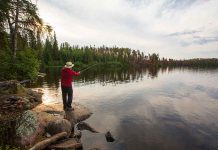#Embrace Winter – It’s Just so Canadian
The snow and cold are here to stay – meteorologists are predicting a classic Canadian winter season with chilly conditions hanging on through April. When heading out into the cold, whether it’s commuting to work, school, or embracing winter sports, it’s important to keep safety in mind.
Before an excursion, make sure you are informed and prepared for potential scenarios to enjoy safe adventures. For example, how do you treat hypothermia? When is ice safe to walk on? Can eyes really be sunburned in the winter? A leader in safety and prevention, Scouts Canada answers these questions and more with essential safety tips so you can head into the cold snowy weather at ease.
(Frozen) water everywhere and not a drop to drink!
Water bottles have a tendency to freeze when outdoors, which is a problem when dehydration leads to greater risk of hypothermia.
Scout tip: store water bottles upside down. Water freezes from the top; so when you’re ready for a drink, the frozen water will be opposite to the spout.
Hypothermia and frostbite
Someone with hypothermia (symptoms include drowsiness, slurred speech, weak pulse, confusion and clumsiness), loses heat faster than they can produce it. If you have hypothermia call for help and move to a warm, dry location, remove wet clothing and keep warm in a blanket. Have a de-caffeinated or herbal hot drink to warm up. If you can’t move indoors, find a spot shielded from the wind and lie down on a warm and dry surface until help arrives.
Frostbite on the other hand, occurs when the top layer of skin and some of the underlying tissue freezes. With frostbite, slowly warm up and loosely apply dry, sterile bandages to the affected area. See a doctor if you experience increased pain, swelling, redness or a fever.
Scout tip: Any exposed skin – not just the head – results in loss of body heat. Wear wool or synthetic materials like nylon, that have water-repelling qualities to stay dry and warm.
Falling through the ice
Before you even venture out, do your research and opt to visit areas where the ice is checked daily by designated authorities, which includes government or national park officials.
Remember this rhyme: “Thick and blue, tried and true; thin and crispy, way too risky.”
A rule of thumb, is if ice is five centimeters or less, appears cloudy and has cracks, breaks and abnormalities, then it’s too thin and isn’t safe to walk on. Remember this rhyme: “Thick and blue, tried and true; thin and crispy, way too risky.” And when in doubt, stay off the ice. Also, be mindful that ice can be hidden underneath the snow, so avoid walking in areas you’re unfamiliar with.
If someone else falls through the ice, stay off the ice and call 911. Help from a distance, using a “long assist” like a rope or hockey stick to gently ease them out. Ask them to crawl along the ice with feet spread. Get to a warm location immediately, remove wet clothing, bundle up in a dry blanket and get a hot drink.
If you fall through the ice, stay calm and turn towards the direction you came from. Place your hands and arms flat on the unbroken ice and kick your feet to try to push yourself up on the unbroken ice on your stomach (like a seal). Once on the ice, do not stand up. Roll away from the unbroken ice and crawl until you are solid ground. Head to a warm location and get dry.
Scout tip: never venture into unknown landscapes alone. Accidents are unexpected, so have an emergency plan in place. Keep an emergency pack handy with a blanket, extra clothing, first aid kit, matches, whistle, snacks and water.
Snow blindness
Snow reflects the sun into unprotected eyes and can cause snow blindness – a sunburn to the cornea. Symptoms include pain or a burning sensation in the eyes, sensitivity to light, headache and blurred vision. Rest indoors, use a cold compress to soothe eye pain and keep corneas moisturized with artificial tears to encourage healing.
Scout tip: wear sunglasses in the winter too!
Prioritizing safety in all activities – whether it’s a day on the skating rink or a week-long winter camping trip in the Canadian wilderness – is key to a successful adventure. And remember – it’s safest to travel with a buddy. If you’re alone, be sure to tell an adult what your plans are and when you expect to be back. Join Scouts Canada to learn firsthand. Registration is open year-round at Scouts.ca/Join.







